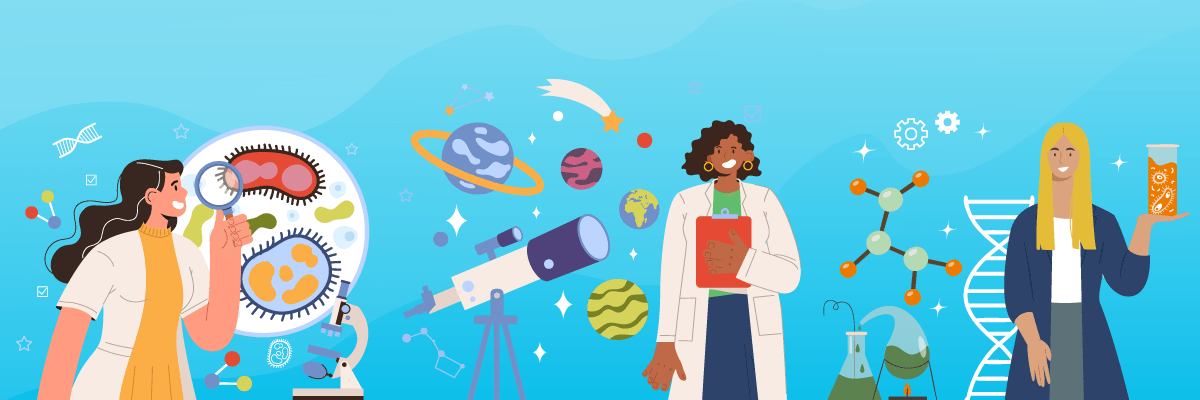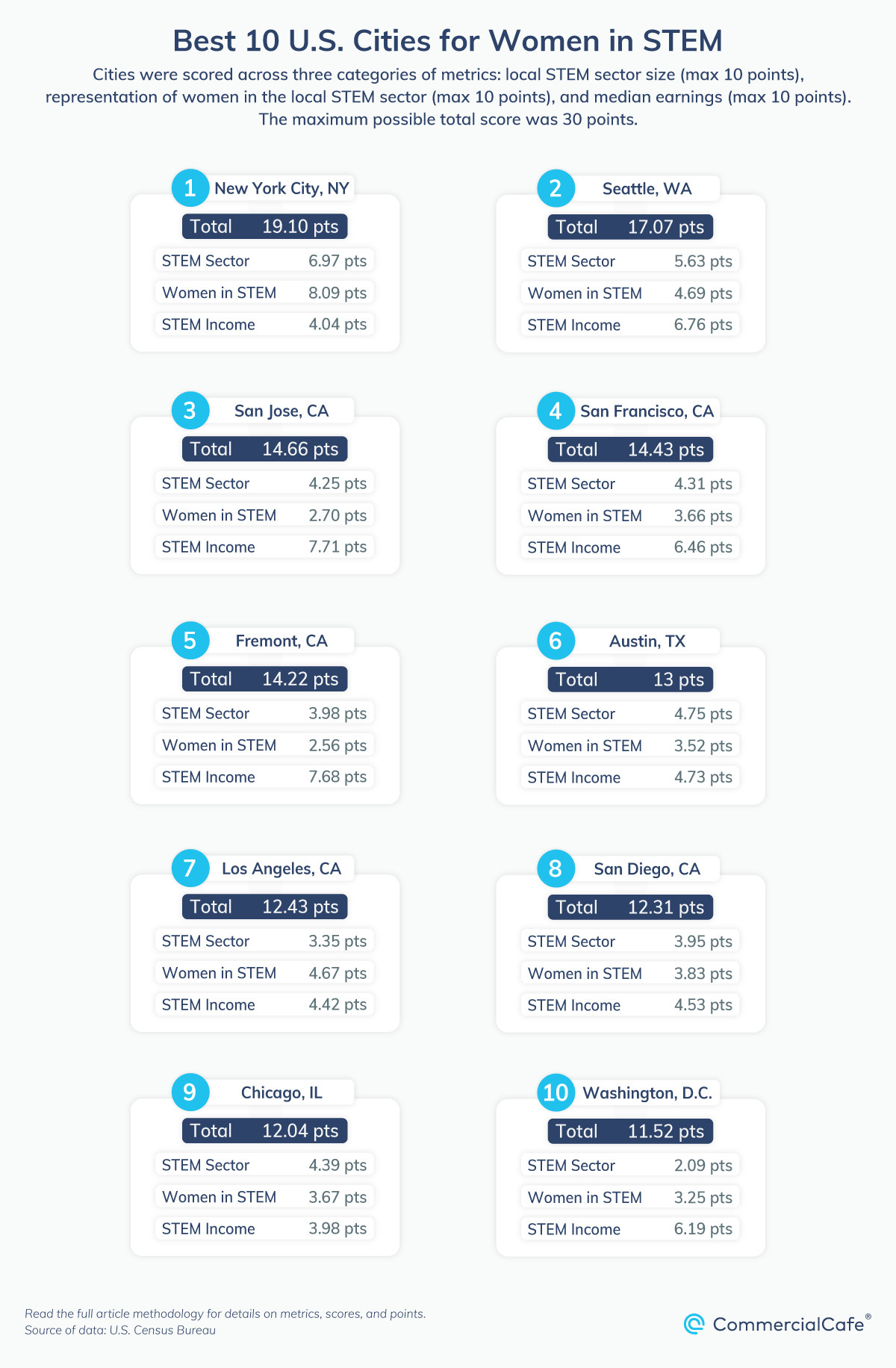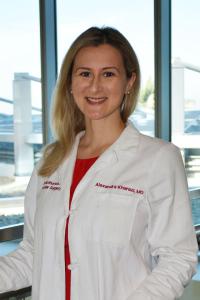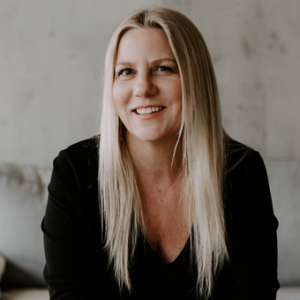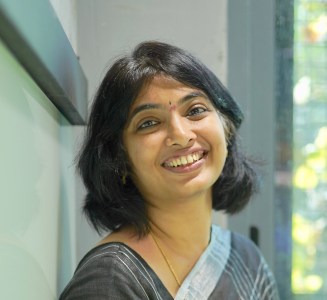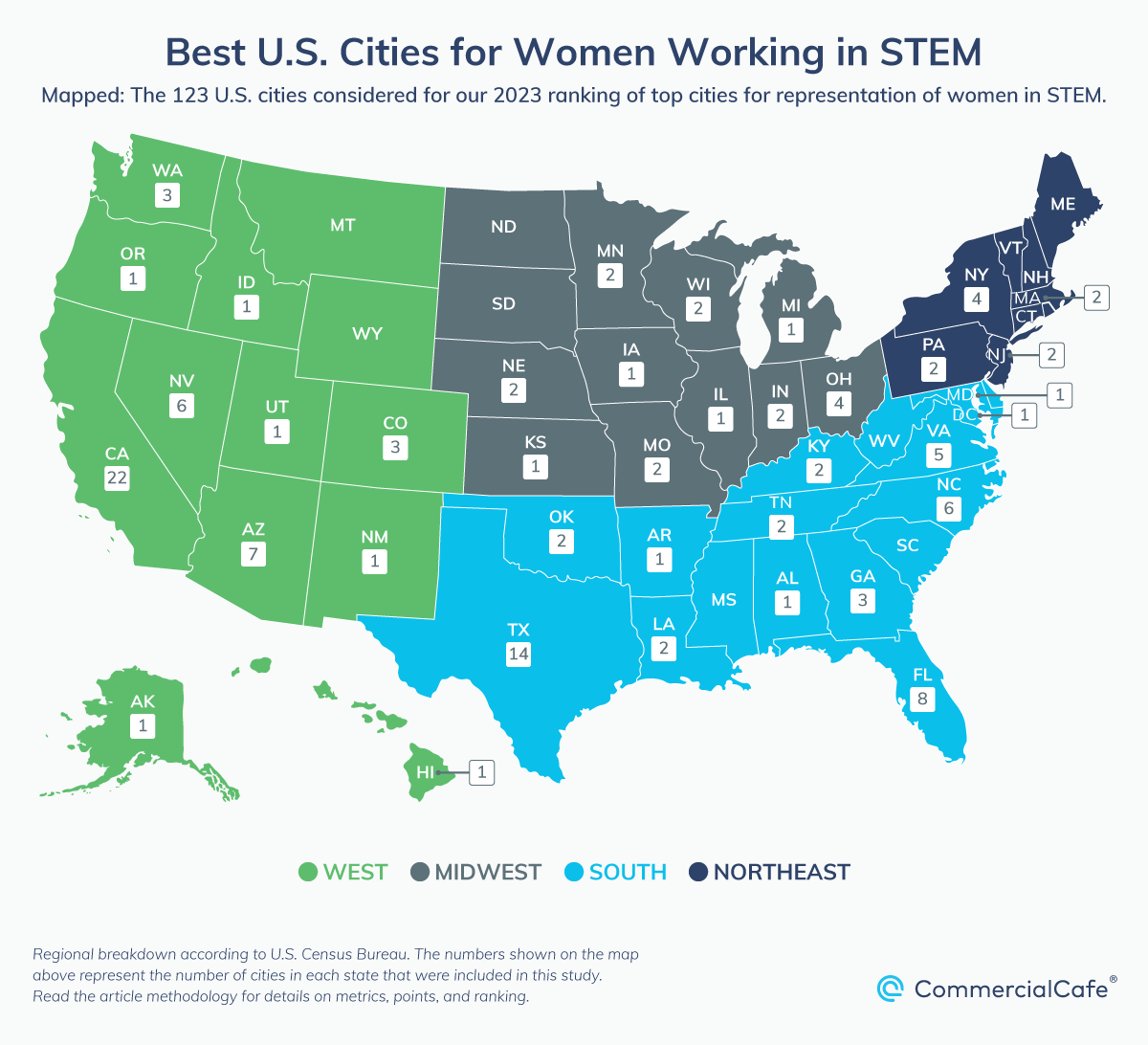Although the COVID-19 pandemic emphasized long-standing inequities and added to the challenges in the pipeline of women in stem, it also shone a light on women scientists who have been hard at work at the forefront of making the world a healthier place for years — such as Dr. Katalin Karikó, Dr. Kizzmekia Corbett, and Dr. Özlem Türeci, who were instrumental in mRNA vaccine research and development.
But, as their own stories have shown, a key early element in women’s eventual success is representation. And, while improvement in this sense has been slow, some places in the U.S. have made more progress than others. So, in the article below, we set out to identify which U.S. cities ranked best for representation of women in STEM. Specifically, we used a methodology that was refined to focus on what we considered to be highly relevant factors, including indicators tracking local STEM employment and the representation of women within it, as well as the levels and evolution of income for women relative to the overall sector in the local economy.
Additionally, following our city ranking highlights are insightful contributions from women STEM professionals who shared what motivated them to pursue a STEM career, as well as some of the challenges they faced.
Western U.S. Claims 6 of 10 Best Cities for Women in STEM
Although New York City earned the highest overall score and took the #1 spot in the ranking, top-scoring Western U.S. cities contributed to a strong presence among the top entries. More precisely, of the 10 U.S. cities that earned the highest composite scores, six were in the Western U.S. region. They included Seattle — which earned the second-best overall score in the national ranking — as well as five California cities that each stood out with notable performance across several of the indicators we analyzed. Meanwhile, the remaining three entries to make the top 10 were Midwestern powerhouse Chicago at #9, along with Southern entries Austin, Texas, (#6) and Washington, D.C. (#10).
Below, see the best-scoring indicators for each of the 10 best cities. Then, read on for details on the best-performing U.S. cities for women working in STEM occupations in each of the four main U.S. regions.
New York City Earns Highest Overall Score, Has Largest Female STEM Workforce
Despite a decrease in the number of residents from 2020 to 2021, New York remained the most populous city in the country by far. As such, it was not surprising that New York City also boasted not just one of the biggest, but also one of the most highly diversified economies in the country: An economy in which both the STEM sector and women’s representation within it have grown considerably in the past few years.
In fact, New York City was home to the largest number of women in STEM in 2021 (nearly 80,000), which marked a representation of 33.2% among local STEM jobs. The city also stood out among the rest for most women STEM workers added in five years. Here, 23,111 more women have joined the local STEM workforce since 2017.
What’s more, the city also claimed the largest number of STEM employees overall among the cities we analyzed: STEM occupations in NYC amounted to more than 240,400 jobs, which accounted for 6.3% of total local employment. This followed a five-year increase of 49,200 STEM jobs since 2017 — the most STEM jobs added among the locations we surveyed for this report.
Outside of NYC, another Empire State location earned the highest score for the percentage of local STEM jobs held by women: In Yonkers, N.Y., women accounted for just less than 50% of the local STEM workforce, marking the largest STEM employment representation among the 123 cities we compared. Notably, the overall STEM sector here was relatively small: STEM jobs added up to a little more than 3,300 in 2021, which represented 3.5% of total local employment. Although Yonkers received the top score for its percentage of women holding local STEM jobs, the city scored out of the top 10, overall.
San Jose Gets Top Score for Earnings of Women in STEM
Census data showed that the best-paying STEM jobs for women were in the heart of Silicon Valley. Namely, in San Jose, Calif., the median income for women in STEM occupations was just less than $122,400 — the highest value among the cities we compared and just ahead of nearby Fremont, Calif., where the median STEM income for women was $122,156 in 2021.
Similarly, women STEM workers in Santa Clarita, Calif., earned the third-highest median income (nearly $109,000), followed by those in San Francisco (fourth-highest with about $103,500) and women in STEM occupations in Seattle (fifth-highest at nearly $102,800).
At the same time, Fremont earned the top score for highest median income of STEM occupations overall ($146,736), as well as for STEM representation overall within the local economy. STEM jobs here accounted for nearly 40% of total employment in the city, which was the largest such share among the cities we compared for this report.
See values scored across all indicators considered for all participating U.S. cities in the interactive table below.
Austin & Washington, D.C. Lead Top Southern U.S. Cities for Women Working in STEM
Of the 123 cities included in our current ranking, 48 are located in the Southern U.S. region, making it the largest regional group in the mix. Moreover, two of the regional selections included here also ranked among the top 10 U.S. cities for representation of women in STEM: Austin, Texas, and Washington, D.C.
Of course, Austin has been a consistently attractive population magnet in the last decade and is still among the fastest-growing cities in the country. So, it was no surprise to find that the city’s best-performing indicators in this ranking were also growth-related. For example, in 2021, there were nearly 8,000 more women working in STEM occupations in Austin than there were in 2017, which marked the fourth-most women STEM workers added in five years among the cities we compared. Plus, within the Southern U.S. region, Austin also had the largest increase in the number of women STEM workers, followed by Charlotte, N.C., (nearly 7,000 added since 2017) and Atlanta (roughly 4,000).
Meanwhile, Washington, D.C. was home to the third-best representation of women in the local STEM workforce among the 123 U.S. cities we compared. The 19,530 women working in STEM occupations in the nation’s capital accounted for 42% of STEM employment in the city in 2021. And, the sector as a whole accounted for a total of a little more than 46,600 jobs in the same year. That represented the 12th-largest local STEM workforce nationally and the third-largest within the Southern U.S. region, where it placed behind Houston (82,876 jobs in STEM occupations) and Austin (87,955 STEM jobs in the local economy).
Likewise, on a regional level, Washington, D.C. earned top score for two income indicators: The capital scored best among Southern U.S. cities for both median income in the STEM sector overall and median income of women in local STEM jobs. Women STEM workers’ median income of nearly $95,000 in Washington, D.C. was the highest among the Southern U.S. cities we compared — ahead of Plano, Texas, ($92,861) and Arlington, Va. ($92,766).
In the West, Seattle Adds More Women STEM Workers Than Top California Cities
The second-largest regional group in the mix was represented by Western U.S. cities, which occupied 47 of the 123 positions in this ranking. Within this group, Seattle placed best with a total score of 17.09 points out of 30. That’s because, in 2021, there were roughly 11,700 more women in STEM occupations in Seattle than there were in 2017 — an increase that marked the most women STEM workers added in five years among the Western U.S. cities we compared. Within the region, Seattle was followed by Los Angeles, which added 9,500 women STEM workers in the same amount of time; and San Diego, where women’s ranks in the STEM sector increased by nearly 6,600.
Additionally, in 2021, women working in STEM occupations in Seattle accounted for 30% of the local sector. They also numbered close to 27,750, which represented the third-largest number of women STEM workers among top Western U.S. cities. In this respect, Seattle ranked closely behind San Diego — home to 27,900 women STEM workers — and Los Angeles, which had nearly 33,200.
Furthermore, women STEM workers in Seattle earned the fifth-highest median income in the Western U.S. region (nearly $103,000), behind San Francisco ($103,534); LA metro’s Santa Clarita, Calif. ($108,832); and the Silicon Valley cities of Fremont, Calif., ($122,156) and San Jose, Calif. ($122,394).
Chicago Has Biggest Female STEM Workforce in Midwest, Cleveland Sees Largest Regional Growth in Representation
The Midwestern U.S. region was home to 18 of the 123 cities included in this ranking. In particular, Chicago — which ranked ninth-best nationwide — earned the top score for six indicators on a regional level. The city scored best among Midwestern U.S. cities for both median income in the STEM sector overall and for median income of women in local STEM jobs: Following a 13% five-year increase in earnings, the median income for women STEM workers in Chicago was nearly $75,000 in 2021.
During the same time, data showed that 7,451 women joined the Chicago STEM sector. Consequently, this represented the most women STEM workers added among the 18 cities in the region. And, with a total of nearly 28,700 women in STEM occupations, Chicago also outranked the other Midwestern region cities for the size of its local female STEM workforce.
Meanwhile, Cleveland scored best in the region for some of the other key indicators of representation. Specifically, between 2017 and 2021, Cleveland saw a 10.6 percentage point increase in the share of women STEM workers — the largest five-year percentage point increase in representation of women in STEM occupations among the 18 Midwestern cities analyzed. In total, the female STEM workforce in Cleveland accounted for a little more than 38% of local employment in the sector, which also marked the largest percentage of representation of women working in STEM in the region. In the same vein, Cincinnati was a very close second as women workers here accounted for nearly 38% of STEM jobs in the city.
Boston Trails NYC as Second-Best Northeastern U.S. City for Women in STEM
Interestingly, only 10 Northeastern U.S. cities were included in our analysis and, of course, New York City led both the national and regional rankings.
On a regional level, Boston received the second-best total score after New York City. In this case, data showed that the Massachusetts life sciences powerhouse was home to the second-largest number of women STEM workers: Boston’s total of nearly 16,000 women in STEM occupations landed behind NYC’s 79,800 and ahead of Philadelphia’s roughly 14,300.
Along the same lines, Boston was also a distant regional second to New York in terms of increasing ranks: In 2021, there were 4,110 more women working in STEM occupations in Boston than there were in 2017, which represented the second-most women STEM workers added in five years among the 10 Northeastern U.S. cities we compared.
We would like to thank the STEM professionals who were generous enough to respond to our questions regarding what inspired them to pursue a career in STEM; what they found to be the biggest challenges along the way; and what they felt had changed for women working or studying in STEM since the onset of the COVID-19 pandemic. Each of the interviews included below also references recommendations of initiatives and organizations that are working toward a better representation of women in STEM, as well as supporting girls who are considering activities and education in any science, technology, engineering or mathematics field.
Alexandra Kharazi, MD, FACS
Dr. Alexandra Kharazi is a San Diego-based cardiothoracic surgeon currently affiliated with Sharp HealthCare.
What inspired or encouraged you to pursue a career in STEM?
Dr. Kharazi: “I’ve always been fascinated by the intricacies of the human body and the incredible potential for medical advancements to improve people’s lives. From a young age, I was inspired by the possibility of using my skills and knowledge to make a meaningful impact on the world. Pursuing a career in STEM not only allowed me to satisfy my intellectual curiosity, but also to channel my passion for helping others into a rewarding profession. Every day as a cardiothoracic surgeon, I have the privilege of working with patients and their families to provide life-saving treatments and compassionate care. I’m grateful for the opportunity to make a positive impact on the world through my work, and I hope to inspire others to pursue their own passions in STEM and beyond.”
What have you found to be the biggest challenge along the way?
Dr. Kharazi: “As a cardiothoracic surgeon, I’ve encountered many challenges on my journey to success. There is the inherent difficulty in mastering a field as complex and demanding as medicine. From long hours in the operating room to extensive studying and training, the path to becoming a skilled surgeon is not an easy one. However, I’ve found that the key to overcoming these challenges is to remain dedicated to your passion and to never give up on your goals.
“Another challenge I’ve encountered is breaking down the stereotypes and biases that still exist within the medical field. While significant progress has been made in recent years, there is still work to be done to create a more inclusive and equitable environment for all. As a woman in a field that has historically been dominated by men, I believe that by staying true to my passions and continuing to work hard, I can inspire other young women to pursue their dreams in STEM fields and beyond.”
What (if any) effect would you say the onset of the pandemic has had on opportunities or possibilities for women studying or working in STEM?
Dr. Kharazi: “As a 36-year-old cardiothoracic surgeon and a woman in STEM, I’ve seen firsthand the impact that the pandemic has had on opportunities and possibilities for women in these fields. With many schools and workplaces closed or operating remotely, women in STEM have faced unique challenges in trying to balance their work and personal responsibilities. The pandemic has highlighted the need for greater flexibility and support for women in these fields and has brought to light some of the systemic barriers that have long prevented women from reaching their full potential.
“However, I also believe that the pandemic has created new opportunities for women in STEM to make a difference. With so many medical professionals working tirelessly to combat the virus, there has been a renewed focus on the importance of science and technology in our world. Women have played a critical role in this effort — from developing vaccines to creating new technologies to support virtual medicine.
“Ultimately, while the pandemic has certainly posed challenges for women in STEM, I believe that it has also underscored the vital importance of these fields and the need for women to be fully represented and supported in them. By continuing to pursue our passions and working together to overcome obstacles, I believe that we can create a more equitable and empowering future for women in STEM.”
Is there an organization or initiative that you would like to highlight that is working to support girls considering STEM fields and/or is working toward better representation of women in STEM?
Dr. Kharazi: “As a fellow of the American College of Surgeons [and] a cardiothoracic surgeon, I’m proud to be a part of an organization that is committed to promoting diversity and inclusion in the medical field. The American College of Surgeons has a number of initiatives aimed at advancing the professional interests of women surgeons and promoting better representation of women in STEM fields.
“One of the most notable initiatives is the ACS Women in Surgery Committee, which works tirelessly to ensure that women are fully represented and supported in the field of surgery. Through this committee, the ACS has developed a wide range of programs and resources to support women in surgery, including mentorship opportunities, leadership training, and networking events.
“Moreover, as a fellow of the American College of Surgeons, I have been able to engage with other like-minded professionals who are dedicated to advancing the field of medicine and breaking down barriers to entry for underrepresented groups, including women. I believe that organizations like the ACS are critical to creating a more equitable and inclusive future for women in STEM, and I am proud to be a part of this effort.”
Dr. Adenike Akinsemolu, Ph.D., Vanguard Fellow at the University of Birmingham
Dr. Adenike Akinsemolu, Ph.D., studies environmental microbiology and is a passionate environmental educator. A Vanguard Fellow at the University of Birmingham, Dr. Akinsemolu is a lecturer at Obafemi Awolowo University in Nigeria and the founder of the Green Institute.
What inspired or encouraged you to pursue a career in STEM?
Dr. Akinsemolu: “My parents have played an essential role in inspiring and encouraging me to pursue a career in STEM. My dad is an engineer, and he always assisted us with our homework and showed us how to fix electronics around the house, sparking my interest in science and how things work. My mother, an educator, registered me in a Young Scientist Club, where I later became the president, and never stereotyped me, buying me STEM gifts that sparked my curiosity. They also bought me all the necessary lab coats and equipment that fueled my passion.
“Growing up in a rural community, I was always curious about the natural world around me and wanted to understand how things worked at a fundamental level. As I advanced through my education, I became increasingly drawn to the fields of microbiology and biochemistry, which offer unique opportunities to explore the complex interactions between living organisms and their environments. With the support of my mentors, I was able to pursue my interests in STEM and achieve my goals.
“I also looked up to women like Wangari Maathai and Jane Goodall, who have made significant contributions to environmental science and conservation. Their work and dedication to protecting the planet motivated me to become an environmentalist and make a difference in my own way. I stand on the shoulders of giants, and it is my responsibility to continue their legacy by inspiring the next generation of young scientists.”
What have you found to be the biggest challenge along the way?
Dr. Akinsemolu: “As a woman in STEM, I’ve faced my fair share of challenges, but the biggest one has been fighting against gender bias and stereotypes that continue to linger in the academic and professional world. It’s frustrating to constantly prove myself and show that I am just as capable as my male peers. Sadly, this is not just an issue that affects me, but is a pervasive problem that women in STEM face worldwide.
“As an environmental microbiologist, I know firsthand how crucial funding is to conducting research and advancing my career. In Sub-Saharan Africa, where I am from, lack of funding is a significant challenge facing many scientists. In a recent survey by the African Academy of Sciences, more than half of the respondents identified lack of funding as the biggest obstacle they face in their careers. On top of that, many universities in the region do not cover the fees for publishing research articles, which makes it even more difficult for researchers to share their findings.
“Another challenge I’ve experienced is a lack of representation at the highest levels of leadership, making it harder for STEM women to advance in their careers. This is something that many of my female colleagues and I have talked about, and it’s clear that more needs to be done to level the playing field.
“Despite these challenges, I remain passionate about my work and determined to make a difference. Female scientists in Africa are incredibly resourceful and innovative. I am inspired by the creative solutions they are coming up with to address some of the most pressing environmental challenges we face. But, to truly break down the barriers that women in STEM face, we need policies and initiatives that provide greater support for research and collaboration and promote gender equality in all areas of science.”
What (if any) effect would you say the onset of the pandemic has had on opportunities or possibilities for women studying or working in STEM?
Dr. Akinsemolu: “The pandemic has had a significant impact on women in STEM, as it has on many other aspects of our lives. In particular, the shift to remote work and online learning has created new challenges and barriers for women who may already be juggling multiple roles and responsibilities. Women are more likely to take on caretaking responsibilities for children or elderly relatives, which can make it difficult to balance the demands of work or study. Additionally, the pandemic has exacerbated existing gender inequalities and disparities, with women experiencing greater job losses and reduced opportunities for advancement.”
Is there an organization or initiative that you would like to highlight that is working to support girls considering STEM fields and/or is working toward better representation of women in STEM?
Dr. Akinsemolu: “I would like to highlight an organization that is very close to my heart: The Green Institute, which I founded to help build the next generation of sustainability science leaders through education, advocacy, and innovation. Our goal is to inspire and engage young girls and women to pursue careers in STEM fields. To this end, we have created several programs, including our Girls Sustainability Prize, which provides mentorship and support to girls interested in science, technology, engineering, and math. It’s important to highlight the contributions of female scientists and leaders in our field. We are actively working toward better representation of women in STEM by advocating for policies and practices that support equity and inclusion.
“At the Green Institute, we believe that the fight for environmental sustainability requires all hands on deck and that we need to tap into the creativity and ingenuity of women and girls if we want to create a more sustainable world. By providing support and encouragement to girls and young women interested in STEM, we hope to inspire the next generation of sustainability leaders who will drive the change we need to see in the world. I am incredibly proud of our work at the Green Institute, and I look forward to continuing to build a brighter, more sustainable future for all.”
A new wave of modernization is sweeping the national office sector and transforming leasing opportunities across all of the most popular markets, including conversions to state-of-the-art life science facilities, medical office space, and more. Select any of the links included below to check out the local listings:
Anastasia Valentine, Startup & Scaleup Advisor, Fractional CRO, CMO & CPO
Anastasia Valentine is a technology and business executive who is leading innovative companies to the next stage of growth.
What inspired or encouraged you to pursue a career in STEM?
Valentine: “I stumbled into it with a temporary placement at a tech company creating graphic design software that turned permanent. I was fascinated by the technology and how it helped people express themselves as artists in a new, innovative way.”
What have you found to be the biggest challenge along the way?
Valentine: “The biggest challenge was upward momentum and keeping that trajectory going at a pace where I felt valued, my work was exceptional and there was an opportunity. The tech industry is very competitive, and I felt the pressure as a woman in STEM. Advocating for myself was critical and switching companies if no opportunities were available at my current employer was essential to keep my career moving.”
What (if any) effect would you say the onset of the pandemic has had on opportunities or possibilities for women studying or working in STEM?
Valentine: “Women studying STEM subjects should look to the pandemic as an opportunity to innovate and remove geographical barriers to talent. While the pandemic was awful, it opened up STEM opportunities for women. The pandemic forced us to be innovative, making companies more open to remote work and creating new solutions that work in a remote environment. Women should leverage this and apply not only for work or study opportunities in their backyard, but in other locations, as well.”
Is there an organization or initiative that you would like to highlight that is working to support girls considering STEM fields and/or is working toward better representation of women in STEM?
Valentine: “I would love to highlight the work of HerVolution and its programs that introduce STEM to girls at a young age and encourage women through their STEM studies so they can see and believe that they can be successful in post-secondary studies and the workforce.”
Rena Lin, Board Member at AGI Labs, AI WIKI Lead Researcher
Rena Lin has a master’s degree from Brown University and is a founding board member of AGI Labs, which is working to advance the interdisciplinary fields of artificial intelligence (AI).
What inspired or encouraged you to pursue a career in STEM?
Lin: “The interdisciplinary nature of STEM and the possibilities it brings to the world have been a constant fascination. As an AI enthusiast, I’ve always been drawn to the potential of combining AI with other fields to create innovative solutions. That’s why I’m proud to work as a researcher at AGI Labs INC., where we’re exploring the frontiers of AI and pushing the boundaries of what’s possible.”
What have you found to be the biggest challenge along the way?
Lin: “One of the biggest challenges I’ve faced in my career is the need for more representation of women in leadership roles in STEM. That’s why I recommended including opportunities for women to develop our product AI Wiki, including funding resources, competitions and other options. We can create a more diverse and inclusive industry by empowering women to take on leadership roles in STEM.”
What (if any) effect would you say the onset of the pandemic has had on opportunities or possibilities for women studying or working in STEM?
Lin: “The pandemic has brought both challenges and opportunities for women in STEM. On the one hand, the pandemic has highlighted the need for innovation and new technologies to address global health challenges. On the other hand, the pandemic has also created new challenges and barriers, such as the need for remote work and the impact of social isolation on mental health. In my case, I got my first job offer to design a pipeline for detecting the sensitivity of specific human genes to COVID back in early 2020, which was a defining moment for me.”
Science-driven startups, incubators, education hubs, representation support events, and more can fit in perfectly with coworking communities, which can often be better positioned within communities than traditional office space. Check out the local coworking listings available in any of the locations linked below:
Sirisha Peyyeti, Senior Vice President of Digital Engineering at Cigniti Technologies
Sirisha Peyyeti has built an IT career spanning two decades and covering a wide spectrum of roles.
What inspired or encouraged you to pursue a career in STEM?
Peyyeti: “There are a large number of opportunities for getting into STEM, irrespective of gender. That provided the much-needed initial impetus. But, subsequently, making a career in STEM was mainly due to the interest in the area. Computer programming had caught up and was throwing many challenges that made it an interesting field, and equally important was the fact that this was a field that provided financial stability with a great career path.”
What have you found to be the biggest challenge along the way?
Peyyeti: “Honestly, I am fairly happy with the way my career progressed. But, I would say, the biggest challenge has been to get over the impostor syndrome completely (it does recur at different stages). There is this inherent need to downplay and not seem sure about the way forward and self-doubt. But, over time, you learn to navigate your way along.”
What (if any) effect would you say the onset of the pandemic has had on opportunities or possibilities for women studying or working in STEM?
Peyyeti: “[The] pandemic meant caregiving responsibilities for women grew — more so for women and girls in [the] lower strata of society where not only did the responsibilities increase, but their access to education (owing to digital) dwindled. That said, most women came out of it being resilient, including some of them starting their own small businesses. This imbibed much-needed confidence.
“Specifically in the IT sector, the pandemic also meant an opportunity to focus on areas of interest and learn new skills. The surge in the need for newer digital skills meant a lot more opportunities, even for people who were on break. The other really interesting thing that happened was to show how being at work for [a] stipulated time was no longer a necessity. This changed [the] mindset [and] made it possible for women who were on a break to rethink about joining the mainstream from [the] comfort of their own homes. I’ve personally known women who’ve picked up newer skills and progressed in their career or started taking up part-time consulting opportunities in IT.”
Is there an organization or initiative that you would like to highlight that is working to support girls considering STEM fields and/or is working toward better representation of women in STEM?
Peyyeti: “I would like to call out the initiative that Cigniti started, herDigitalStory. This initiative provides a platform for women in technology to network and discuss or debate some of the latest and greatest happenings in the tech industry. Each session will have women in [the] tech field present their story and viewpoints on their areas of work. This will also provide them with an opportunity to network and understand the great work that other women are doing in this field.”.
Methodology
Choosing the Cities
For this analysis, we looked at U.S. urban centers with populations of 200,000 or more. Population totals considered for city selection were according to U.S. Census Bureau estimates for 2021. This criterion was not factored into the scoring system.
All data was sourced from the U.S. Census Bureau. The most recent information available pertaining to the metrics considered for the purposes of this article was dated 2021. Data scored for each metric was at the city level. To each city, we assigned composite scores based on 12 metrics, which we grouped into three categories (detailed further below).
For the regional breakdown of our analysis, we followed the U.S. Census region divisions:
- Western U.S. states: Alaska, Arizona, California, Colorado, Hawaii, Idaho, Montana, Nevada, New Mexico, Oregon, Utah, Washington, and Wyoming.
- Midwestern U.S. states: Illinois, Indiana, Iowa, Kansas, Michigan, Minnesota, Missouri, Nebraska, North Dakota, Ohio, South Dakota, and Wisconsin.
- Southern U.S. states: Alabama, Arkansas, Delaware, Florida, Georgia, Kentucky, Louisiana, Maryland, Mississippi, North Carolina, Oklahoma, South Carolina, Tennessee, Texas, Virginia and West Virginia, in addition to Washington, D.C.
- Northeast U.S. states: Connecticut, Maine, Massachusetts, New Hampshire, New Jersey, New York, Pennsylvania, Rhode Island and Vermont.
Metrics, Scores & Points
For each metric, the number of maximum points was evenly distributed between the lowest and highest metric values within the group. On this scale, a score was calculated for each city based on its metric values. Scores for the top 10 cities were the result of comparison across the entire set of 123 cities analyzed. Conversely, city scores in the breakdown by U.S. region were the result of comparison across each respective regional subset.
For all indicators, the number of points awarded was directly proportional to the metric values. Each city’s overall score was calculated by adding the scores for each metric. The factors (metrics) on which we based the composite scores are explained below within their respective categories.
Local STEM Employment Sector
Metrics grouped in this category totaled a maximum of 10 points, which were distributed as follows:
- The STEM employees 2021 metric referred to the number of STEM jobs out of the total number of local jobs. The maximum weight for this metric was three points.
- To gauge the evolution of the STEM employment sector in each city, we compared 2017 employment data with 2021 employment data. The value scored represented change (either positive or negative) in the number of STEM jobs for each city. The maximum weight for this metric was three points.
- STEM % of local employment represented the percentage of STEM occupation jobs out of the total of all jobs for each city. The maximum weight for this metric was two points.
- To gauge the evolution of overall STEM jobs in each city, we compared 2017 employment data with 2021 employment data. The value scored represented change (either positive or negative) in percentage points of the share of STEM occupations jobs for each city. The maximum weight for this metric was two points.
Representation of Women in the Local STEM Sector
Metrics grouped in this category totaled a maximum of 10 points, which were distributed as follows:
- The women STEM employees 2021 metric referred to the number of STEM jobs held by women out of the total number of local STEM jobs. The maximum weight for this metric was three points.
- To gauge the evolution of women’s employment in the local STEM sector, we compared 2017 employment data with 2021 employment data. The value scored represented change (either positive or negative) in the number of female STEM employees for each city. The maximum weight for this metric was three points.
- For women % of STEM jobs we calculated the percentage of female employees out of the total number of employees in STEM occupations, per 2021 Census information. The maximum weight for this metric was two points.
- To gauge the change in local representation of women in STEM jobs, we compared 2017 employment data with 2021 employment data. The value scored represented change (either positive or negative) in percentage points of the representation of women in STEM occupations jobs for each city. The maximum weight for this metric was two points.
Local STEM Income
Metrics grouped in this category totaled a maximum of 10 points, which were distributed as follows:
- Values scored for median earnings represented the median annual income of residents who worked in STEM occupations, as available in the most recent Census data. The maximum weight for this metric was three points.
- To gauge the change in local STEM wages in five years, we compared 2017 income data with 2021 income data. The value scored represented the percentage change (either positive or negative) of median annual earnings in STEM for each city. The maximum weight for this metric was two points.
- Values scored for women in STEM median earnings represented the median annual income of female residents who worked in STEM, as available in the most recent Census data. The maximum weight for this metric was three points.
- To assess the change in local women STEM workers’ median annual earnings in five years, we compared 2017 income data with 2021 income data. The value scored represented the percentage change (either positive or negative) of women’s median annual earnings in STEM for each city. The maximum weight for this metric was two points.
See the detailed ranking scores across all indicators considered for all participating U.S. cities in the interactive table below:

